
Venereal Disease Treatment Menu: 1 2 3 4 5 6 7 8 9 10 11 12 13 14 Next>>
Venereal Diseases in the Golden Age of Piracy, Page 9
Treating VD During the GAoP: First Stage (The Clap) - Curing Gonorrhea Discharge
Specific Balsamic Compounds to Cure Gonorrhea
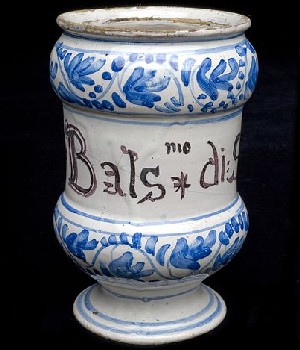
Balsam Pharmacy Jar, From the Wellcome Collection
The other medicines mentioned for treatment of the pus discharge caused by gonorrhea are used to heal the urethra passage which the period sea-based medical men felt was damaged by the passage of pus through it. These medicines are mostly based on balsams.
Sea surgeon John Atkins explains that "there is no doubt a Period, which the Skilful discern, wherein a Change for healing Balsamick Medicines is necessary, and required; and which, as we come short of, or exceed, may be either way pernicious"1. However, Atkins only lists one medicine which appears to be balsamic. "Rx.. Terebinth. Venet. [Venetian turpentine] {1/2 ounce} Vitell. ovi. [egg yolk] syr. Bals. [balsamic syrup] {1 ounce} M. [mix] in Cyatho [a small measure of] Vin. alb. sumend. [white wine]"2.
Cockburn discusses balsamic medicines, although he says that when they are used in gonorrhea, their function is different than when they are used on regular wounds, making them behave more like astringents which either stop or slow the flow of pus from the urethra. Despite this comment, he goes on to list ten healing medicines including five 'white mixtures', three electuaries and two pills which can be used to treat gonorrhea. Those which use ingredients that can be found in the surgeon's medicines chests from the period include:
(White Mixtures) … Rx. Aq. Calc[is]. [Water of slaked lime] {1 gallon} Opobals[am] [balsam of Gilead]. Capyv. [balsam of Capivi] vel. [or] peruvian. [Balsam of Peru] {1/2 dram} Ovi. vitelli auxilio F. Mistura alba. [egg yolk and white mixed]. Hujus, vel præcedentis [either this or the preceding], Cochlear. {3 spoonsful} ter indies accipiat [taken three times a day].
Rx. Opobalsam, {30 drops} Cap. e cochleari cum sacchari albiss. s. q. [taken with half a spoonful of white sugar]

Artist: Eugen Kohler
Myroxylon balsamum tree, From Medizinal-Pflanzen (1897)
Rx. Rhab. tost. [toasted liquorice] Nuc. moschat. tost. [toasted nutmeg] Balsam. Tolutan [balsam of Tolu, from the Myroxylon balsamum tree] {of each, 15 grains} Sachar. Saturn. [sugar of lead] {6 grains} Terebinth. venet. [Venetian turpentine] q. s. M. F. Bol. [a sufficient quantity to make a bolus] Mane & hora somni sumendus. [Take in the morning and at bedtime.]
Rx. Cass. recenter extract. [Cassia, freshly extracted] Terebinth. Vent. [Venetian turpentine] {of each 2 scruples} Mercur. dulc. [sweet mercury precipitate] {1/2 scruple} M. F. Bol. [make into a bolus] Mane vorandus. [Take early in the morning.]
Rx. Terebinth. venet. [Venetian turpentine] {2.5 drams} Dracon. mitigat. [sweet mercury sublimate] {10 grains} M. F. Bol. [make into a bolus] Hostia involvend. ut exhibeatur alternis diebus. [given on alternate days]
(Electuaries) Rx. Pulp. Cass[ia]. recent. extract. [Cassia wood, recently extracted] {1 dram} Terebinth. venet. [Venetian turpentine] {2 ounces} Merc. dulc. [sweet mercury precipitate] Ocul Cancr. preparator. [prepared crab’s eyes] Sal. Prunell. [crystal mineral] {of each, one dram} Sal Volatil. [smelling salts or spirit of hartshorn] succin. [amber] {of each, 4 scruples] Syrup. de Alth[ea] Fernel. [Syrup of Marshmallows, the recipe specified by Jean Fernel] q. f. M. F. Conditum [a sufficient quantity to make a preserve]; de quo capiat magnitudinem Nuc. moschat. major. [of which take an amount the size of a large nutmeg] bis terve de die. [two or three times a day].
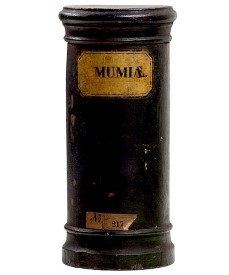
Artist: Christoph Braun
Mumia, Museum für Hamburgische Geschichte
…Rx. Electuar. lenitive[um]. {2 ounces} Balf Capy[vi]. {6 drams] Ocul. Cancr. Prepar. [prepared crab’s eyes] {3 drams], Nuc. Moschat. ras. [rasped nutmeg] Sal. Prunell [crystal mineral], {of each, 2 drams} Mercur. Virid [green precipitate – mercury iodide], {4 scruples} M. F. Electuar. [make into an electuary]
Rx. Sang. Dracon[is] [dragon's blood resin]. Amyl[um]. [white starch] {of each 3 drams} Oppobals[am] [balsam of Gilead], {1.5 ounces} Terebinth. Cypriæ [Cypress Turpentine] {1.5 drams}, M. Sachar. apud, pistores Saccharias [mix with baker’s (white) sugar], infurno incrustetur [bake brown in an oven]; de quo Cap. ter vel quater in die. [of which, take three or four times a day]
(Pills) Rx. Mum[ia] [Mummy}, sang. Dracon [dracon's blood resin], terebinth. Coct. [boiled turpentine] Corall. rubr. Ppti. [prepared red coral] {of each 2 scruples} Balsam. Peruvian. q. f. M. F. pilular Massa [a sufficient quantity to make a pillular mass]; de cujus singulis drachm. forment. pil. x. [from which fashion 10 pills weighing a dram] Cap. iv. harum omni vesperi & multo mane [take four every morning and evening].3
1 John Atkins, The Navy Surgeon, 1742, p. 234; 2 Atkins, p. 235; 3 William Cockburn, The Symptoms, Nature, Cause and Cure of a Gonorrhoea, 1713, p.120-2
Other Procedures for Curing Gonorrhea
In addition to the variety of medicines administered to treat gonorrhea, a few procedures were employed by the period sea surgeons and physicians. One of them is used in conjunction with the medicines. Sea surgeon John Atkins' gives a prescription which calls for the use of cupping glasses as part of the application of the medicine.
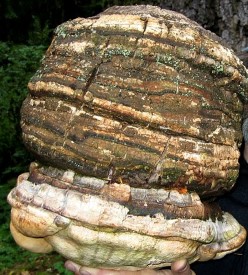
Artist: Dusty Yao Stamets
Agaric Mushroom, Agarikon laricifomes officinalis
Rx. Sal Prunel. [crystal mineral] {3 drams} Pulv. Rhabarb. [powdered rhubarb] {2 drams} Troch. de Agaric. [Lozenge of Agaraic - containing Agaric mushrooms, white wine and ginger] Alhandal. [Lozenge of Alhandal] an. {of each, 2 drams} Antim. Diaphoret. [Lozenge of Diaphoretic Antimony - containing diaphoretic antimony, saltpeter and spirit of wine] CC [a cupping glass] ppt. [prepared with] Mer. dul. [sweet mercury sublimate] bene levigate [well smoothed], rez Jalap [and jalap resin]. an. {of each, 1 dram} Elect. Lenitiv[um]. {2 ounces} Bals. Capivi q. s. sumat ad magnitud. Castaneae [of a sufficient quantity to make the size of a chestnut] omni Mane & Vespere [taken in the morning and evening].1
Here, the lip of the cupping glass was to be smeared with mercury and jalap, both of which had purging properties. Since agaric mushrooms, sal prunell, electuary lentivum and rhubarb are all purges, this medicine is definitely a purge. How the cupping glass would improve its function isn't clear.

Artist: Louis Le Nain - Peasants Eating and Drinking (c. 1642)
Most of the other procedures are concerned with diet. Sea surgeon John Moyle writes that the patient being treated must avoid "strong Liquors, and keep to fresh and wholsom Diet."2 In his book on venereal diseases, Atkins explains, "I begin the Cure with a strict Regulation in Living, particularly an Abstinence from spirituous Liquor and salt Food"3. He goes even further in his book written for sea surgeons, explaining that "Nature herself, in [people with] good Constitutions, with proper Dieting only, would run off [the malignancy of gonorrhea] in a due Quantity of Time; and that our Administrations are but her Assistants thereto"4.
There are a couple of other suggestions made by the period sea surgeons to help defeat gonorrhea. Moyle mentions that the patient "must forbear the Actio Venerea [intercourse]"5, although he doesn't explain why.
Atkins recommends "the use of the Cold-Bath; it gives a Contraction and Tensity [tenseness] to the Fibres in general, and therefore must close the Orifices of these Ducts in particular."6 Atkins comment suggests that this will help keep the gonorrheal taint from spreading to other parts of the body.
1 John Atkins, Lues Venerea, not dated, p. 30; 2 John Moyle, Chirugius Marinus: Or, The Sea Chirurgeon, 1693, p. 139; 3 Atkins, Lues Venerea, p. 25; 4 Atkins, The Navy Surgeon, 1742, p. 233; 5 Moyle, p. 139; 6 Atkins, Lues Venerea, p. 31-2
Treating VD During the GAoP: First Stage (The Clap) - Painful Urination Cure
Although there are a wide variety of cures and medicines recommended for stopping the running of pus from the urethra,
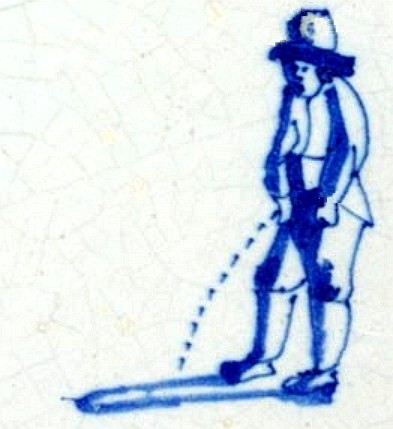
Man Urinating (Somewhat Painfully), Dutch Delft Tile (17th century)
the period surgeons had much less to say about a dysuria. In order to better propose cures, the sea doctors of the period felt it was necessary to identify the cause of the problem.
Sea surgeon John Moyle suggests that it is "Excoriations [torn skin] in the [urethral] passage causing difficulty and pricking in making the Urine."1 Naval surgeon William Cockburn looks at the problem the other way around, suggesting that the problem is the urine itself. He explains that "the Pain of Urining is from the Saltness of the Urine; and that the Pain is taken off, by diminishing the Saltness"2. He later expands on this idea, stating that the "Method of Alleviating Pain [in urinating], is, either by defending the Urethra from being Affected with the Salt of the Urine; or else by rendring the Water less Salt[y]."3 The fact that he sees the need to defend the urethra acknowledges Moyle's assertion that damage to the urethra causes the pain.
Probably having his fellow sea doctors comments in mind, sea surgeon John Atkins combines Moyle's and Cockburn's diagnoses, suggesting that "Disuria is a Necessary Consequence of the Running, it being a Pain from the Acriminious Salts of Urine wasting thro' the Parts which that [running pus] has excoriated."4
With this knowledge, the sea-based doctors could propose ways to cure dysuria. Although Atkins discusses and even names the problem, he does not provide any specific
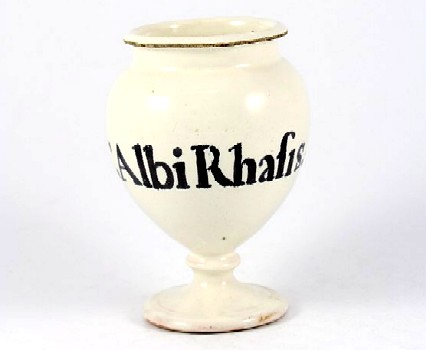
Photo: Aurélie Troccon et Manon Mauquin - Medical Container for Troch Albi Rhasis
prescriptions for treating it, instead indicating that the treatment for stopping running pus will also end the problem of painful urination. If, as he suggests, the pus running through the urethra causes it to be sensitive to the overly salty urine, removing this running should cure both problems simultaneously.
Moyle provides a more specific suggestion for remedying this problem, involving injecting an astringent medicine into the urethra. This is presumably with the idea that it will contract the irritated skin and decrease the pain caused during urination. He tells the readers of his second book, "you are to inject by Syringe, that known Lotion, of aq. Plantag. [plantane water], and Pulv. Troch. alb. Rhass. mixed, let it be done often."5 Astute readers will recognize these are the same basic ingredients he recommended to treat running pus. Similar to Atkins, Moyle suggests that one medicine can cure both problems.
Cockburn is much more expansive in recommending a solution. He notes that "Cold Medicines [referring here to the humoral property of a medicine to cool, not the temperature of the medicine], being likewise mucilaginous [thick and sticky], [have] the Effect of diluting the Salts of the Urine, and besmearing the Urethra with a Mucilage"6. He follows this with a list of 12 medicines that may be used to accomplish this end. We will focus on those containing ingredients that are most likely to be found in the sea surgeon's medicine chests.Photo: Ondřej Mangl
Smelling Salts or ,
Spirit of Hartshorn
Rx. Sal. Volatil. succin. (smelling salts - spirit of hartshorn) {1 dram} Sach. Candidæ [white sugar] {2 drams} M. F. dos. vj. [make into 6 doses] Harum unam accipiat ter in die [Take one of these three times a day] e [after drinking] Cyatho Tincturæ Theæ [a cup of tea], Cerevisæ tepide [warm beer], vel [or] seri lactis [whey].
Rx. Crystall mineral. {1 dram} F. dos. ij. [make 2 doses] unico die Sumendæ cum Haustu quorumlibet Liquorum prædictorum. [When drank in a single day of taking any of the aforementioned liquids - tea, warm beer or whey.]
…Rx. Amigdalar. dulc. [sweet almonds] par. viij. [8 of appropriate size] Decoct. Hord. [barley water] {2 gallons} F. s. a. Emulsio [make according to art], cui add. [to which add] Sacchar. albiss. [white sugar] q. s. ad gratiam [a sufficient quantity to make it pleasing], Hauriat tribus vel quatuor vicibus. [Drink three or four times.]
Rx. Semin. iv. frigid. major. [the four major cold seeds - cucumber, muskmelon, pumpkin and watermelon - admittedly, these varied from book to book] {1 ounce} papa ver. alb. [white poppy seeds], {2 drams}, amigd. dulc. [sweet almonds} {8 each} Contundantur sensim affundendo [gently crush and pour into] aq. petroselin. [parsley water] {1.5 gallons} F. Emulsio [make into an emulsion] sacharo Candiæ [white sugar] ad gratiam edulcoranda [add and sweeten until pleasing]. …
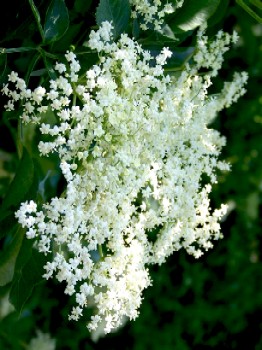
Photo: Trish Steel
Elder Flowers, National Geographic Society
Rx. Seri lact. [whey] {1/2 gallon} gum. Tragacanth. {2 drams} solvatur gummi [(make a) gummy solution] & injiciatur Misura [and inject the mixture].
Rx. Ag. plantagin. [plantane water] {10 ounces} Trochiscor. albor. Rhas. [white lozenge of Rhassis] {1/2 dram} M. et eluatur Urethra Syryngæ auxilio [inject with syringe to wash the urethra].
Rx. Flor. Sambuc. [elder flowers] {1 handful} rad. alth. [marshmallow roots] {1/2 ounce} semin. Cydonior. [quince seeds] {1 dram} Preparent. s. a. [prepare according to art] et decoquant. in aq. [and decant in water] {1.5 gallons} Utatur Colatura. [Strain and use.]
Rx. Rad. Hyodciam. [henbane root] {1/2 ounce} furfur. siligin. [wheat bran] {1/2 handful} semin. lin. contus. [bruised flax seed] {2 drams} Decoq. in [boil in] aq. Rosar. [rose water] {2 gallons} Frigescant cooperta [cover cold], Liquor postea colatus [after the liquid is purified] injiciatur in Urethram [inject into the urethra] bis vel ter in die [two or three times a day].7
1 John Moyle, Chirugius Marinus: Or, The Sea Chirurgeon, 1693, p. 140; 2 William Cockburn, The Symptoms, Nature, Cause and Cure of a Gonorrhoea, 1713, p.65; 3 Cockburn, p. 135-6; 4 John Atkins, Lues Venerea, not dated, p. 17; 5 Moyle, Chirugius Marinus: Or, The Sea Chirurgeon, 1693, p. 140; 6 Cockburn, p. 139; 7 Cockburn, p. 140-1
Treating VD During the GAoP: The Transformation of a Clap Into a Confirmed Pox
A crucial part of the Universal Source Theory of venereal diseases was that a failure to properly treat the first stage - the Clap - would cause the venereal taint to retreat into the body and transform into the second stage: a Confirmed Pox. This idea has already been mentioned several times in the various sections about The Clap. However, this section pulls all the loose ideas together providing a more cohesive explanation of how the period medical men understood this transition.
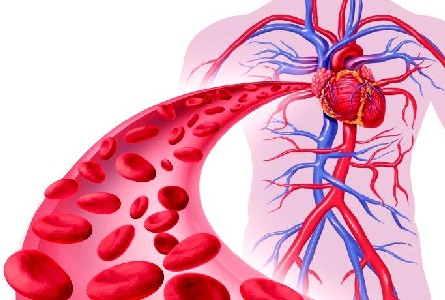
Fancy Image of Blood Flow and Circulation
Moyle explains that the patient is in the first stage of venereal disease "when the venemous humour lyeth about the Genitals or Seed-Vessels, and hath not yet infected the mass of blood, nor got into the bones."1 Moyle elsewhere says that a "Morbus Venereus, a confirm'd Pox, [occurs] when it hath passed the Liver, and is got into the blood, and that the spots and pustles appear, and nodes and night pains are felt."2 Thus, according to Moyle, the change from a Clap to a Confirmed Pox takes place when the venereal taint leaves the genitals and permeates the rest of the body via the blood. (The liver was thought to be where blood was generated.) Sea surgeon John Atkins agrees, stating that from "improper handling, the Virulency will revert into the Blood, and produce all the Symptoms of a Pox"3.
How this happened was cause for much discussion by the period medical men. Over-use and misuse of medicine received a large amount of blame. German military surgeon Matthias Gottfried Purmann explained that when gonorrhea is "repelled by the Applications of contrary Medicines, as Mercurials, or great Coolers, and Astringents, or is Scarified [a part is bled by making multiple incisions in it] or Opened before it comes to Maturity, then no thing can be expected but a confirmed Pox, because the Venereal matter is driven back again."4 He goes on to explain that the venereal poison will then "infect the whole Mass of Humours [fluids in the body] " in the body, after which it "Ascends and Disorders the more Noble Parts of the Body."5
Both Atkins and naval physician William Cockburn point to astringents and/or purges as the source of the trouble. Atkins says, "If (while the Signs of Malignancy abide) too sudden a Check be given to the [gonorrheal] Running, either by the unseasonable use of Astringents, or too quick and strong purging in the beginning, which turns to the same; then it will either revert and taint the whole Mass of Blood"6. Cockburn notes that when "
Artist: Veloso Salgado
William Harvey, From Medicina do
Renascimento (1906)the Corrupted Running [of gonorrheal pus], receiving any Check from Astringent Medicines, will flow into the Blood, poyson it, and produce the Pox"7.
Moyle adopts an entirely different point-of-view, explaining that if the surgeon uses any medicines other than purges to stop a gonorrheal running, "he Causes it to mingle with the Blood, and so become a confirm’d Pox"8.
Both Moyle and Cockburn warn against bloodletting when treating gonorrhea. Moyle's says that "letting of Blood will do the like; for that revulsion [moving humors away from a site through mechanical means] makes for the malign Atoms or Fumes to ascend from the Pocky ferment [venereal taint] in the Inferior parts [the sex organs], and teints the blood in the Superior [the internal organs and head]; and so by and by intolerable Headach, and other confirm’d Symptoms succeed."9
Cockburn's explanation is a bit different, although it basically says the same thing. He first advises that when treating the problem of painful urination, bleeding the patient will cause the doctor to find "that Practise has not only failed them; but it has sometimes brought in the Pox, as some of them confess."10 He goes on to say that "the Reason for this is obvious enough from the Doctrine of Bleeding anciently acknowledged, and excellently Accounted for by the great Doctrine of the Circulation."11 He is likely William Harvey's theory of circulation, first found in his 1628 book De motu Cordis et Sanguinis in Animalibus and again later in the 1653 book The Anatomical Exercises of Doctor William Harvey Professor of Physic and Physician to the King’s Majesty, Concerning the Motion of the Heart and Blood. His point appears to be that when blood is taken, it draws the venereal taint into the circulatory system and causes it to be distributed throughout the body.
1 John Moyle, Abstractum Chirurgæ Marinæ, 1686, p. 89; 2 Moyle, Abstractum, p. 93; 3 John Atkins, Lues Venerea, not dated, p. 13; 4 Matthias Gottfried Purmann, Churgia Curiosa, 1706, p. 340; 5 Purmann, p. 341; 6 Atkins, Lues Venerea, p. 28; 7 William Cockburn, The Symptoms, Nature, Cause and Cure of a Gonorrhoea, 1713, p. 112; 8,9 John Moyle, Chirugius Marinus: Or, The Sea Chirurgeon, 1693, p. 139; 10 Cockburn, p. 139; 11 Cockburn, p. 143;

